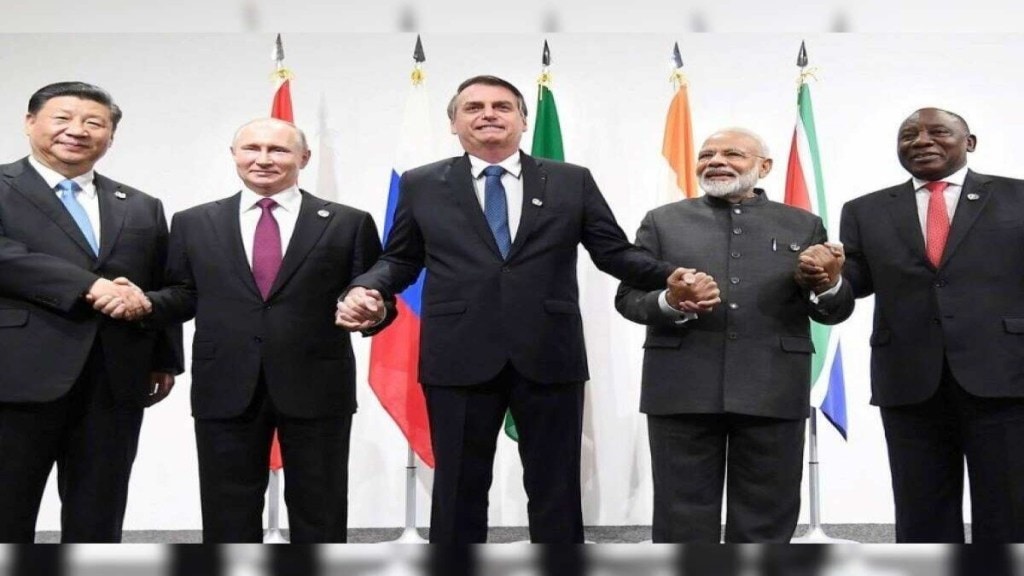By Rajan Kumar, Priyanshu Agarwal & Indrapal Gurjar
In a recent social media post, Donald Trump issued a stern warning to the BRICS countries against their attempts at de-dollarisation and efforts to develop an alternative currency. He threatened that the US would slap a 100 per cent tariff if BRICS sought to develop a new currency. In his words, the BRICS must ensure that ‘they will neither create a new BRICS currency nor back any other currency to replace the mighty US dollar’. Dropping all pretence of civility, he bluntly stated that BRICS can find another ‘sucker.’ His words have generated a fierce debate among the BRICS countries concerning the implications of moving away from dollars for international financial transactions.
Trump’s statement is a reaction to the proposal by some BRICS leaders to develop an alternative currency for trade among member-states, thereby reducing dependence on the US dollar. For instance, Brazil’s President, Lula da Silva, stated in 2023 that ‘it is time for the BRICS nations to create a new payment method’. He further stated that a new currency increases our payment options and reduces our vulnerabilities. Russia and China are keen to reduce their dependence on the dollar because the US has used its currency as an instrument to achieve geopolitical gains. This defies the logic of currency being regulated solely by the market forces.
Russia and China accuse the US of weaponizing the dollar to retain its global hegemony and weaken its competitors. Recently, the US and its allies sanctioned Russia and expelled it from the SWIFT payment system, making it difficult for Moscow to conduct international trade. Moreover, they froze Russian foreign assets lying in Western countries. This created a panic not only in Russia but also in the Global South countries, which have been victims of sanctions in the past and fear such actions in the future. The West has frozen Russia’s foreign assets worth $300 billion following the Russian invasion of Ukraine.
Similarly, Iranian assets of roughly $100 billion have also been frozen. Russia has effectively been cut off from the Western financial systems. These actions have adversely impacted global confidence in the US dollar, prompting many states to search for an alternative payment system. As per IMF data, the US dollar has lost around 10 percentage points of its share of global foreign exchange reserves since the turn of the century.
However, the prospect of a BRICS currency faces several structural challenges. The biggest obstacle is the absence of a reference currency among member states and the impracticality of returning to a gold standard. The new currency will require a high level of coordination of monetary and financial policies. Given the low level of cooperation among the BRICS states, this is unlikely to be achieved in the short term. Moreover, the diverse economic systems and varying stages of development in these countries make such a task difficult to achieve. BRICS states also fear the predominance of Chinese currency in such a system. New Delhi has adopted a cautious approach towards de-dollarisation due to its deep-rooted ties with Western economies and its rivalry with China. Therefore, adopting a BRICS currency appears to be a rhetorical proposition rather than an achievable outcome. Russian President Vladimir Putin, during his interview with reporters from BRICS countries before the Kazan summit, clearly stated that BRICS currency ‘is not under consideration.. .. The time has not come yet.”
However, an interesting development is underway, and BRICS states have begun trading in local currencies. More than 90 per cent of Russia-China trade is in ruble-renminbi. Similarly, around 90 per cent of India-Russia trade is now being conducted using local currency, according to Russian Deputy Prime Minister Denis Manturov. Russia is trading with all other BRICS nations in local currencies. How far will this impact the dollar, and how will Mr. Trump respond to that remains to be seen!
Having said that, the US dollar will remain the dominant currency in the short and medium term. According to the Dollar Dominance Monitor of the Atlantic Council, the US Dollar maintains a whopping 88 per cent share in global foreign exchange transactions and 58 per cent in the global foreign exchange reserves. The total international trade in 2023 stood at $30.5 trillion, and the intra-BRICS trade stood at less than $2 trillion. Therefore, even if BRICS develops an alternative currency or it decides to trade only in local currency, the dollar will continue to dominate the global financial transaction. Trump need not fear the BRICS currency, as it is not happening anytime soon!
About the authors: Rajan Kumar teaches at the School of International Studies, Jawaharlal Nehru University. Priyanshu and Indrapal are research scholars in SIS
Disclaimer: Views expressed are personal and do not reflect the official position or policy of FinancialExpress.com Reproducing this content without permission is prohibited.

